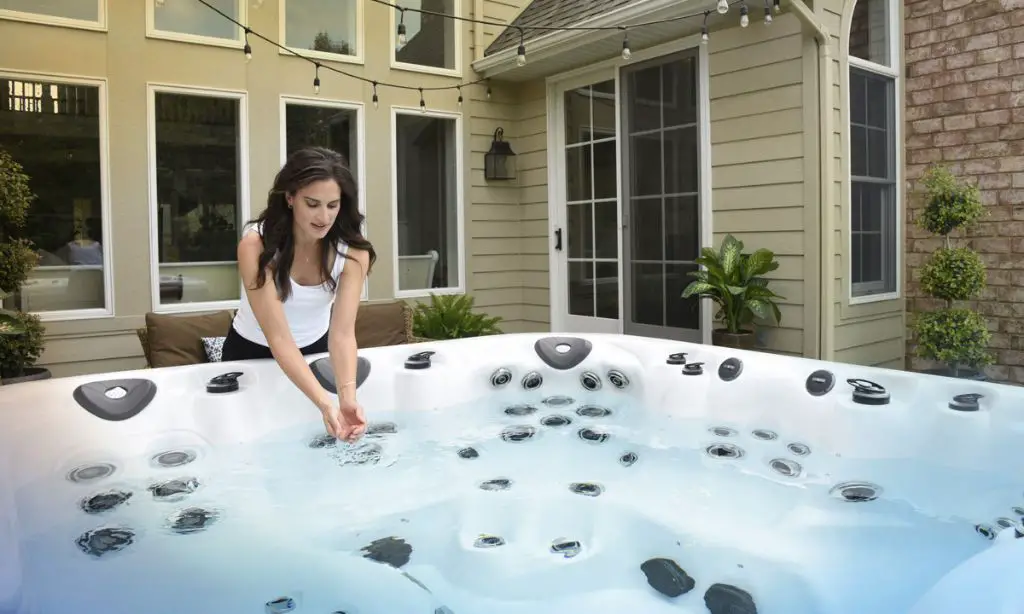When it comes to keeping your hot tub clean and sanitized, the two most common options are chlorine and bromine. Both work to kill bacteria and other contaminants, but they have some key differences. Deciding which one is better for your hot tub depends on factors like maintenance requirements, user comfort, and cost. This article examines the pros and cons of chlorine vs. bromine so you can determine the best sanitizer for your needs.
Page Contents
How Do Chlorine and Bromine Work?
First, it’s helpful to understand what both chlorine and bromine do in a hot tub. Here’s a quick overview:
Chlorine
- Kills bacteria, viruses, and algae by destroying their cell walls and structures
- Available as tablets, granular chlorine, or liquid sodium hypochlorite
- Fast-acting but don’t last as long as bromine
- Produces a strong chemical odor and can irritate eyes/skin
Bromine
- Releases free bromine that oxidizes and destroys contaminants
- Typically used with chlorine to boost sanitizing power
- Provides long-lasting residual sanitizing ability
- Available as tablets or granules
- Doesn’t produce a strong chemical smell
While they work differently, both chlorine and bromine effectively kill bacteria and viruses to keep water safe. Bromine provides more stable, long-lasting sanitation while chlorine works faster but doesn’t last as long.
Maintenance and Testing
Maintenance is a key factor when deciding between chlorine and bromine. Here’s how the requirements compare:
Chlorine
- Requires frequent testing and adjusting of chlorine levels
- Chlorine level can change quickly with sun, heat, rain, and use
- May need daily testing and chlorine addition
- Chlorine shock treatments may be needed to superchlorinate
- pH must be monitored and adjusted regularly
Bromine
- Provides a more stable level that doesn’t deplete as quickly
- Typically only need to test bromine levels 1-2 times per week
- Requires less frequent shock treatments
- pH still needs regular monitoring and adjustment
In general, bromine is lower maintenance since it provides a more stable residual sanitizer level. Chlorine requires frequent testing and addition of chlorine to maintain proper levels.
User Comfort and Experience
Chlorine and bromine hot tubs provide a different bathing experience. Here are the key points to consider:
Chlorine
- Can cause dry, irritated skin and eyes
- Has a strong chemical odor, especially at higher levels
- Some users may be sensitive to chlorine
- Fast acting so you notice sanitizing benefits right away
Bromine
- Doesn’t irritate eyes or skin as much
- Low chemical odor
- Less likely to cause sensitivity or allergy issues
- Provides a softer, gentler spa experience
Many hot tub users prefer bromine because it doesn’t irritate skin and the chemical smell is less noticeable. Bromine won’t sanitize as fast as chlorine but can provide a better overall user experience.
Cost Comparison
Cost is another factor to weigh when choosing a sanitizer. Here’s a look at how chlorine and bromine compare:
Chlorine
- Chlorine tablets are inexpensive and widely available
- Liquid or granular chlorine is more expensive than tablets
- May require frequent purchases since it depletes quickly
- Frequent testing and adjustment also increases long-term costs
Bromine
- Bromine tablets tend to be more expensive than chlorine tablets
- May not need to purchase as frequently since levels are more stable
- Less frequent testing can save money over time
- Overall lifetime cost can be lower than chlorine
While bromine tablets tend to cost more upfront, the long-lasting properties and reduced testing needs can offset the higher initial price over time. For budget-conscious hot tub owners, bromine can cost less in the long run.
Ease of Use
How easy each sanitizer is to use also factors into deciding between the two:
Chlorine
- Very simple to add chlorine as needed to maintain levels
- Liquid or granular chlorine dissolves and mixes quickly
- Chlorine tablets use a floater or feeder that can clog or stick
- Requires frequent testing and adjustments
Bromine
- Typically used with a bromine floater for automated dispensing
- Bromine tablets may stick together or clog the floater
- Don’t need to test and add bromine as often
- Long-lasting and stable levels means less overall maintenance
For hot tub owners who want simplicity, liquid or granular chlorine is very easy to use as needed. Bromine feeders automate the process but require occasional maintenance when tablets stick. Bromine wins when it comes to infrequent testing and long-lasting levels.
Consider a Combination
Many hot tub owners get the best of both worlds by using a combination of chlorine and bromine:
- Use bromine tablets for consistent residual sanitizing
- Periodically shock with chlorine for a quick sanitizing boost
- Gets the convenience and stability of bromine
- Benefits from the fast action of periodic chlorine shocking
- Less need to continually test and adjust sanitizer levels
Using both bromine and periodic chlorine shocks provides effective hot tub sanitation with less frequent monitoring and maintenance. The bromine takes care of day-to-day sanitizing while the chlorine gives the tub a clean “reset” as needed.
Conclusion
When it comes to keeping your hot tub clean, both chlorine and bromine are good options. Here are some final guidelines for deciding between the two:
- Choose bromine for lower maintenance and softer water
- Pick chlorine if you want fast-acting results and simplicity
- Consider a bromine and chlorine combo for the best of both
- Factor in your budget since bromine costs more upfront but can be cheaper long-term
- Make sure your sanitizer works with your hot tub brand and components
- Follow all manufacturer instructions for proper sanitizer use
With the right sanitizer choice and water care routine, you can enjoy clean, clear hot tub water for years to come. Test different options to find your ideal hot tub sanitizer.
